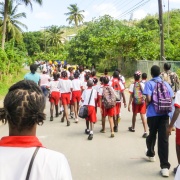“This is What Hope Looks Like on the Reservation.”
The Rosebud reservation in South Dakota is one of poorest communities in the U.S. Our community partners in the reservation share their perspectives on the reality and needs of the community as well as ways to overcome these challenges. This is the story of their work to support the people of the Rosebud reservation and the role for volunteers in that work.
Warming hearts and homes
“Mother” Lauren Stanley points to towering pile of cord wood. “This is what hope looks like on the reservation,” she asserted. She’s overseeing a production line of volunteers in Mission, South Dakota who are splitting and stacking the wood for distribution to families in all reaches of the Rosebud Reservation. It’s the centerpiece of a winter fuel program – #FirewoodfortheElders – which is a project for Global Volunteers in the summer months.

On the Rosebud Sioux Reservation of South Dakota, where Reverend Dr. Lauren Stanley is Presbyter of the Episcopal Mission West, access to basic resources is limited. “The greatest daily challenges (for families) are actually finding the resources for food, electricity, and gas. With unemployment ranging from 65 to 85 percent, and high costs for everything because of our location, just getting enough money together for daily life is difficult.” she explains.
No one who’s visited the Lakota Nation questions Rev. Stanley’s perception. Todd County, where the reservation is located, is the second-poorest county in the nation, with nearly 50% of residents living below the poverty line of $22,314 income for a four-person household. “When any unexpected expenses or emergencies arise, it can be impossible. If you need repairs to your house, buying any supplies or finding someone who can do the work is hard and frequently, people are scammed.” That’s where Global Volunteers comes in. The teams work with local people in the summer months to chop and store firewood for distribution during the frigid winter months, help repair homes, and conduct “sports and art camps” for children.

“It’s a statement of the value of the people here; someone else is saying, ‘Our children matter’.”
Rev. Lauren Stanley
“The volunteers’ two key values are: One, the fact that they are willing to come here to serve the people. That is a statement of the value of the people here; someone else is saying. ‘Our children matter’,” Rev. Stanley asserts in her characteristic staccato. “And two, the work they do as volunteers saves people immensely on the costs.”

Feeding bodies and spirits
Showing people “they matter” is the nexus of Mother Lauren’s work and Global Volunteers’ focus on helping children. The second major work project is helping conduct summer camps in June and July to provide structured recreational activities and at least two meals a day.
“We’re very intentional about how we work with my babies here on the “Rez,” Rev. Stanley continues. “Jesus says to feed the hungry. That’s what we do without an agenda.” She points out that 98% of students qualify for the federal free lunch program, and 78% qualify for free breakfast. Hunger and food insecurity are constants.

According to the U.S. National Institute of Health (NIH), food insecurity (defined as limited and uncertain availability of healthy foods) is strongly correlated with malnutrition and underweight as well as obesity and type 2 diabetes. One out of four Native Americans/American Indians are “food insecure,” the NIH report says. “We’re a food desert here,” says Rev. Stanley. “There are limited fresh foods, and costs are very high because most of our food is trucked in.” Most school students get at least one nutritious, filling meal at school each day in the primary and secondary schools throughout the 1.26M-acre reservation in south-central South Dakota.
“The first thing we do is feed them.”
Rev. Lauren Stanley
But, in the summer months, kids may miss out on USDA summer food service programs because parents are unable to get them to meal sites. Of the 20 communities on the reservation, only 15 have summer feeding programs. That’s the importance of meals at the summer camps, Rev. Stanley says. “We pick them up and fill out the paperwork to keep them safe. But the first thing we do when we get them here is feed them.” Global Volunteers’ van and team of volunteers are instrumental in the smooth operation of this process.

The camps enable the kids to play games and learn new crafts and skills from the volunteers. Day-campers are between the ages of 5 and 13, and generally are easy to entertain. Teen volunteers who accompany their parents are especially well-suited for the high activity level and short attention span in the camp programs.
“We serve everyone on the Rosebud, and we are very generous in helping people with food, gas, diapers, and other supplies – regardless of their religious affiliation or non-affiliation. So volunteers are well received, and the people here welcome them well, work with them, feed them, and interact with them well,” Rev. Stanley says. Then adds: “It’s pretty simple.”
You might also like:












Leave a Reply
Want to join the discussion?Feel free to contribute!